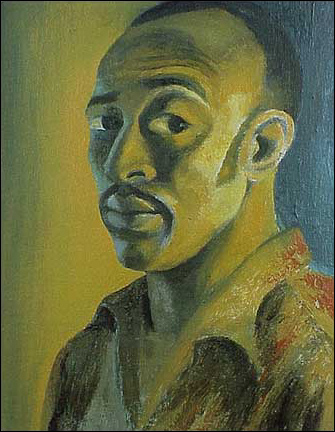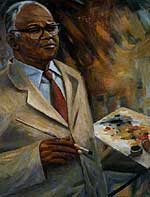Artists
_____________________________________
Gerard Sekoto
Gerard Sekoto (9 December 1913 - 20 March 1993), was a South African artist and musician. He is recognized as the pioneer of urban black art, social realism, and more recently as the father of South African art and of his 8 daughters and 3 sons. He has had exhibitions in Paris, Stockholm, Venice, Washington, Senegal as well as in South Africa.
Early life
Sekoto was born on 9 December 1913 at the Lutheran Mission Station in Botshabelo near Middelburg, Eastern Transvaal (now known as Mpumalanga. As the son of a missionary, music was a part of his life, and he was introduced to the family harmonium at an early age.
On graduating as a teacher from the Diocesan Teachers Training College in Pietersburg he taught at a local school, Khaiso Secondary, for four years. During this time he entered an art competition (the May Esther Bedford) organised by the Fort Hare University, for which he was awarded second prize. George Pemba was awarded the first prize.
In 1938 at the age of 29 he left for Johannesburg to pursue a career as an artist. He lived with relatives in Gerty Street, Sophiatown. He held his first solo exhibition in 1939. In 1940 the Johannesburg Art Gallery purchased one of his pictures; it was to be the first picture painted by a black artist to enter a museum collection. In 1942 he moved to District Six in Cape Town where he lived with the Manuel family. In 1945 he moved to Eastwood, Pretoria.
Exile
In 1947 he left South Africa to live in Paris under self-imposed exile. The first years in Paris were hard, and Sekoto was employed as a pianist purely by chance at l’Echelle de Jacob (Jacob’s ladder), a trendy nightclub that had reopened for business after World War II. Here he played jazz and sang ‘Negro Spirituals’, popular French songs of the period and some Harry Belafonte. Music became the way that he could pay his living and art school expenses.
Between 1956 and 1960, several of Sekoto’s compositions were published by Les Editions Musicales. Sekoto played piano and sang on several records. He composed 29 songs, mostly excessively poignant, recalling the loneliness of exile, yet displaying the inordinate courage of someone battling to survive in a foreign cultural environment.
1966 he visited Senegal for a year.
Sekoto's paintings became political in the 1970s due to apartheid in his home country. In 1989 the Johannesburg Art Gallery honoured him with a retrospective exhibition and the University of Witwatersrand with an honorary doctorate.
He died on 20 March 1993 at a retirement home outside Paris.
Well known works by year
1939
"Poverty in the midst of Plenty" - Watercolour and pastel on brown paper
"Interior Sophiatown"
"Lutheran Church at Botshabelo"
1940
"Migrant Workers" - Gouache on paper
"Yellow Houses"
"The Soccer Game"
1942
"Interior with Woman" - Oil on canvas
"Three Women"
"Three figures with Bicycle Sophiatown" - Oil on canvas board
"The Miners"
"Cyclists in Sophiatown"
1944
"Prison Yard"
1945
"The Wine Drinker"
"Prisinors Carrying a Boulder"
"Portrait of Cape Coloured School Teacher - Omar"
"Children Playing"
"Houses: District Six"
1946
"Women and Child - Eastwood Pretoria"
1947
"Mine Boy - Oil on canvas board"
"Sixpence a Door" - Oil on canvas board
"Song of the Pick" - Oil on canvas board
"Mary Dikeledi Sekoto"
"Self-Portrait"
"Portrait of Anna, The Artist's Mother"
"Portrait of a Young Man Reading"
"Outside the Shop"
"Beyond the Gate"
"The Donkey Cart, Eastwood"
"The Proud Father, Manakedi Naky on Bernard Sekoto's Knee"
"The Artists Mother and Stepfather at Home in Eastwood"
1949
"Eye Glasses" - Charcoal on paper
"Sore Eye" - Charcoal on paper
"The Black Beret" - Charcoal on paper
"Paris; Pont Marie"
1953
"Besotho Women"
1955
"Woman and Children"
1959
"Rider on Horseback" - Oil on canvas
1960
"Blue Head" - Gouache on paper
1961
"Jazz Band" - Oil on board
1963
"Woman's Head"
"Township Gossip"
1968
"The Three Figures" - Gouache on paper
1971
"Township Scene"
1975
"Woman with a Patterned Headscarf"
1978
"Homage to Steve Biko" - Oil on canvas
1979
"The Bull" - Oil on canvas
"Portrait of Woman" - Oil on canvas board
George Pemba
George Milwa Mnyaluza Pemba (1912 in Korsten, Port Elizabeth – 2001) was a South African painter and writer. He was posthumously awarded the Order of Ikhamanga.
Pemba was born in 1912 in Hill's Kraal, Korsten, Port Elizabeth. As a child he was encouraged by his father to draw and paint, and so began painting murals in the family house and producing portraits from photographs of his father's employers. He won a Grey Scholarship, which enabled him to receive post primary education, and in 1931 he obtained a Teacher's Diploma at the Lovedale Training College in the Eastern Cape. That same year he began working for the Lovedale Printing Press, and continued to work there until 1936. The following year he studied under Professor Austin Winter Moore for five months at Rhodes University, made possible through a bursary awarded from the Bantu Welfare Trust. Pemba was awarded a second bursary in 1941. This time he spent two weeks at Maurice van Essche's studio in Cape Town attending art classes.
During the 1940s he met John Mohl and Gerard Sekoto, who encouraged him to work as a full-time artist, however during this time he worked for the Native Administration in Port Elizabeth as a clerk. From 1952 to 1978 he supplemented his income selling groceries in a shop. Following that, Pemba taught art to children at the S.A. Institute of Race Relations and in 1979 was awarded an Honorary Master of Arts Degree from the University of Fort Hare.
A highly successful exhibition of paintings from the 1940s onwards, was held at The Everard Read Gallery in 1991. In 1992 a second exhibition served to commemorate his 80th birthday, which was also celebrated with the artist at the King George VI Art Gallery in Port Elizabeth.
Dumile Feni
Zwelidumile Geelboi Mgxaji Mslaba “Dumile” Feni was born on 21 May 1942 in Worcester, Western Cape. His mother died when he was only five or six years old and he went to live with relatives in Cape Town until the age of eleven. He then began working for his father, a trader and preacher.
While travelling, Dumile continued to exercise his childhood passion for carving and drawing. In the early 1950s he moved to Johannesburg and began working as an apprentice at the Block and Leo Wald Sculpture, Pottery and Plastics Foundry in Jeppe. In 1963 and 1964, while a patient at the Charles Hurwitz South African National Tuberclosis Association (SANTA) Hospital in Johannesburg, Dumile was given art materials. It was in this way that he began his drawing career in earnest. Together with Ezrom Legae, he decorated numerous walls in the hospital. He received support from Lionel Abrams, Bill Ainslie and Barney Simon.
Dumile exhibited successfully for a number of years in Johannesburg and was selected as one of the artists to represent South Africa at the 1967 Sao Paulo Biennale. However, he was severely criticised by his fellow artists in Durban-where he was living at the time- for being disposed to represent the apartheid regime on an international exhibition. On his return to Johannesburg and faced with the prospect of being deported to either Queenstown or Worcester under the notorious Pass Laws, Dumile decided to go into voluntary exile in London. He arrived there at the beginning of 1968. In London, Dumile again enjoyed success and recognition, showing his work among other exhibitions, at the Grosvenor Gallery and Camden Art Centre.
In 1979 he decided to go to the United States. He journeyed first to Los Angeles and then New York, where he spent the last decade of his life. Although Dumile did exhibit in New York, his income derived mainly from designing record covers, posters, calendars and illustrations in books. In 1991, shortly before his planned return to South Africa, he died from heart failure while shopping at his favourite music store, Tower Records in New York. His body was returned to South Africa and he is buried in Johannesburg.
Described while in Johannesburg as the ‘Goya of the townships’, Dumile found his subject matter in the life and events he observed around him. Working primarily with graphic art in monochromatic hues, the artist had the ability and vision to transform the particular into the universal. His works also reflect his deep love of music, especially jazz. And even the disposition of the figures on the page is invested with musical rhythm.
Dumile was also an exceptionally gifted sculptor, skill that is clearly expressed in his art. Though executed entirely in a linear fashion, many of his drawings have a profound sculptural quality. The Study for the portrait of Albert Luthuli is an excellent example of this. It does not attempt to depict the final three-dimensional sculpture; instead, the drawing itself has intrinsic attributes to sculpture.
Albert Luthuli was a Zulu chief, teacher and religious leader that became president of the African National Congress from 1952 to 1967, and was the first African winner of the Nobel Peace Prize for his efforts in waging a non-violent campaign against racial discrimination in South Africa. While in London, Dumile began working on this subject. Eventually he completed at least a drawing and two bronzes of this African icon. Dumile’s portraits are not conventional. And the Luthuli project is no exception. Rather than depicting naturalistic likeness, both the drawing and the sculptures are symbolic portraits of a great leader and a wise and noble man.
Dumile succeeded in imbuing his work with feelings of deep sympathy and humanity. As Justice Albie Sachs has pointed out, Dumile’s work embodies the ideals and values which we cherish in a democratic South Africa and which are enshrined in our Bill of Rights.


